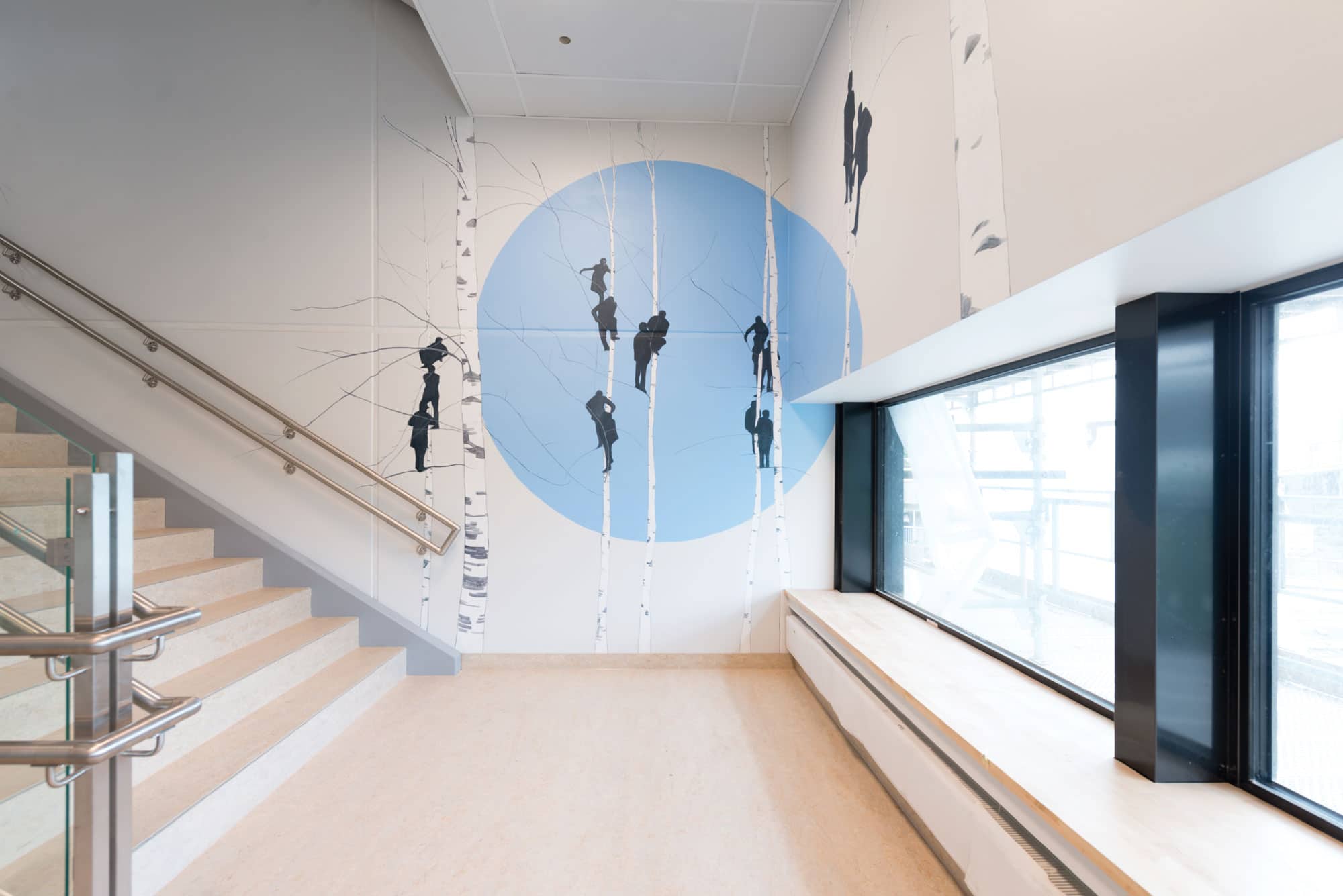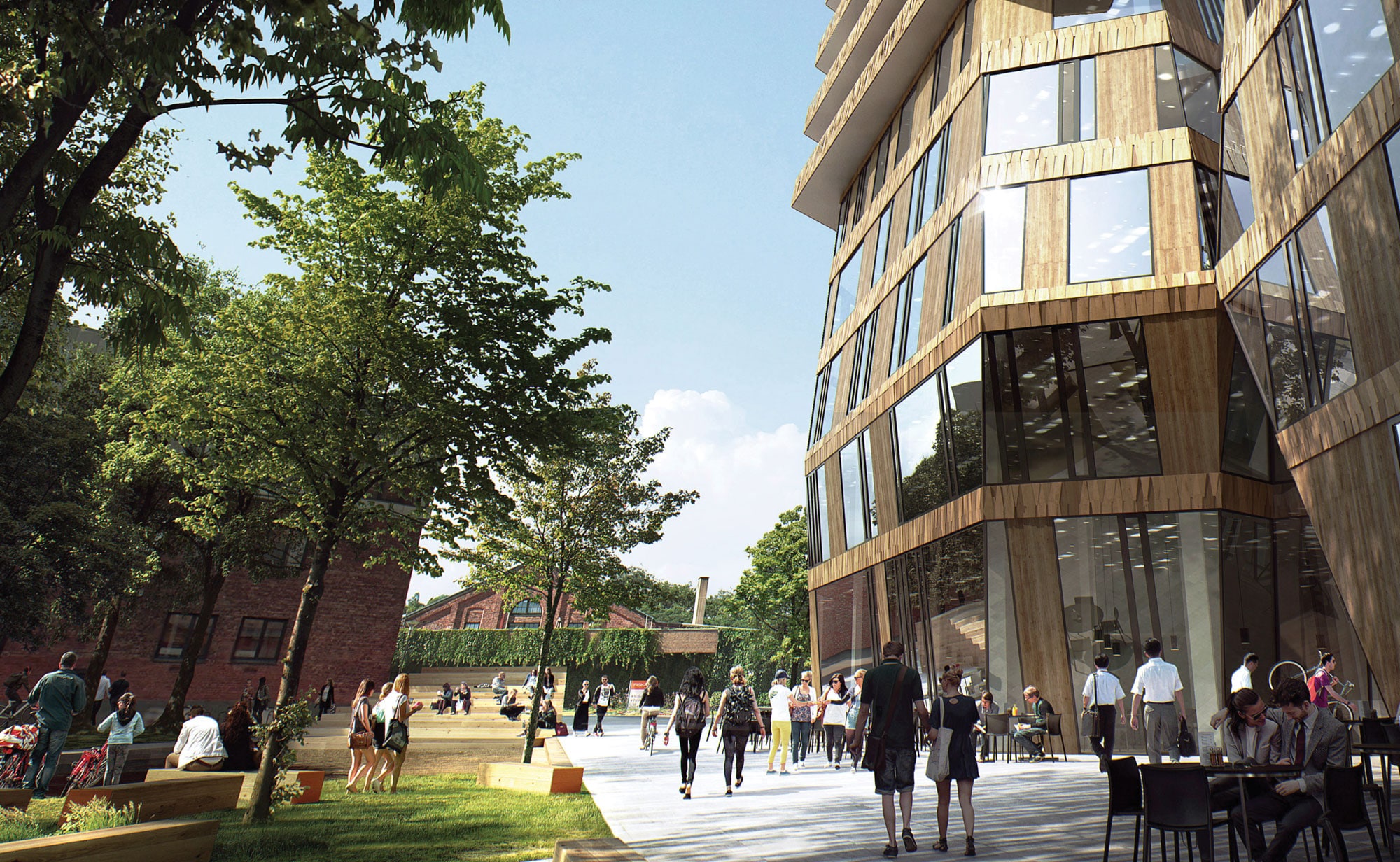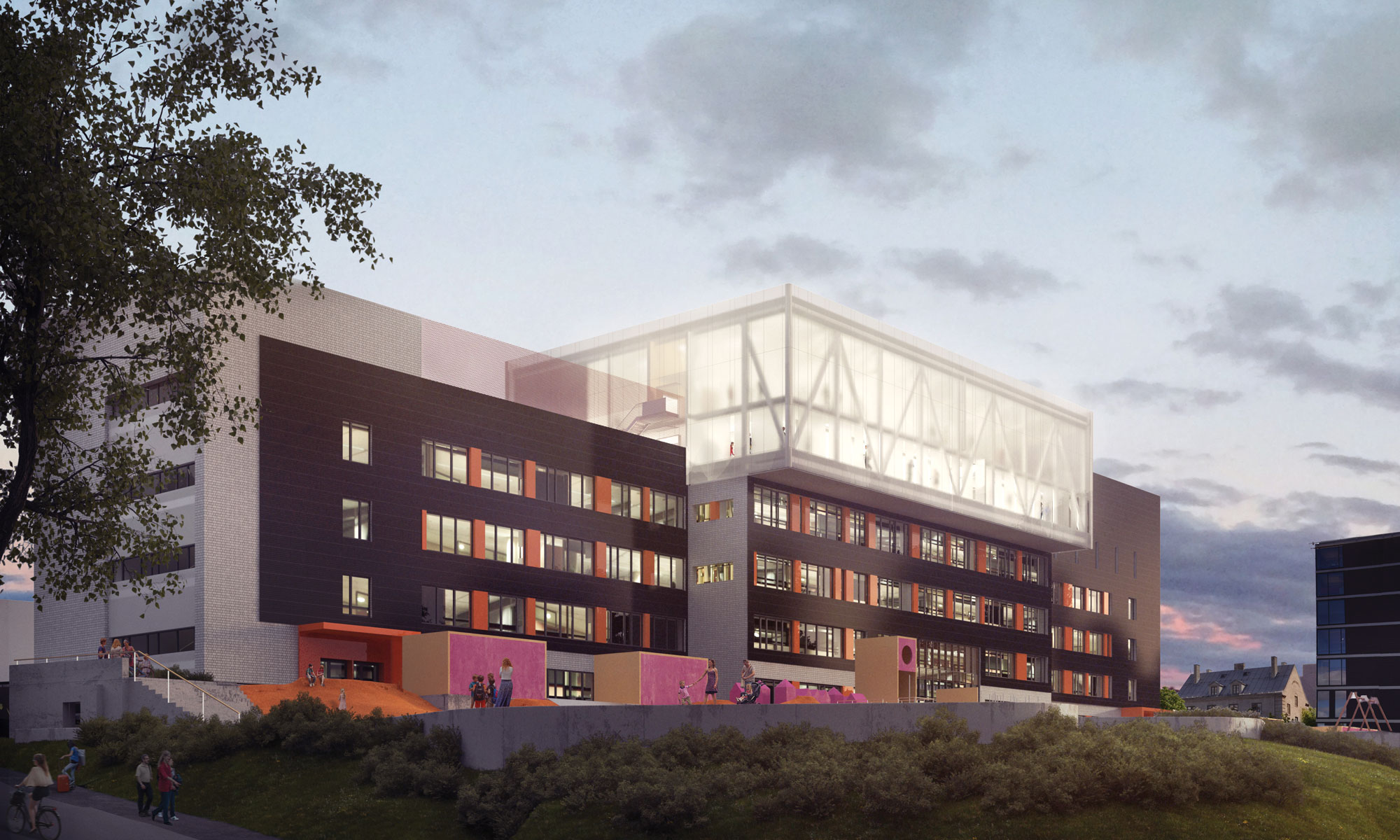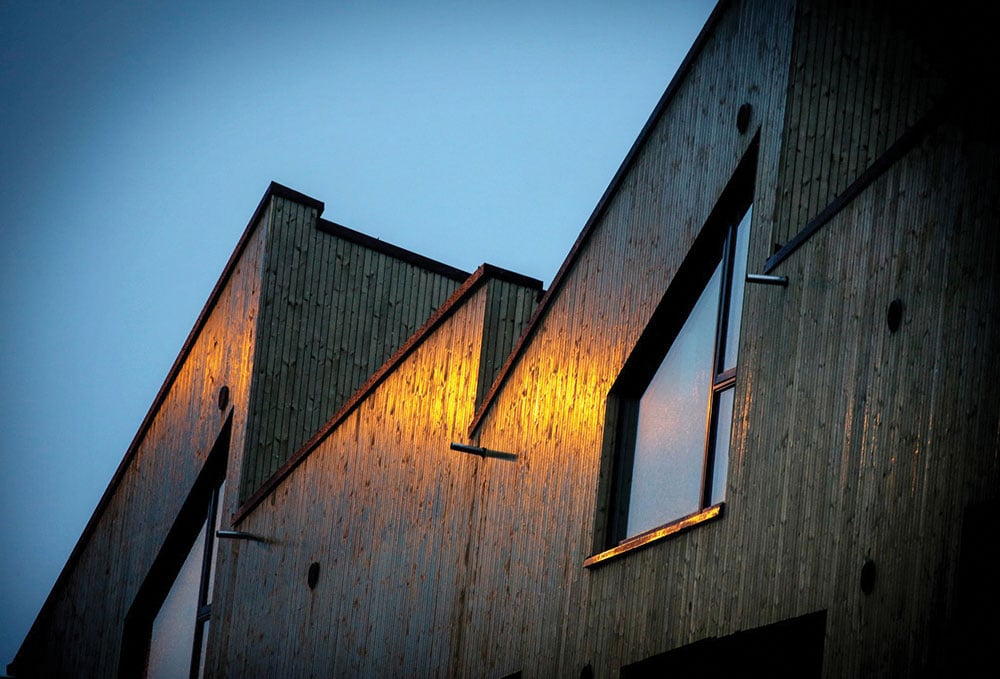
Norway’s most energy-efficient school, Brynseng School, includes nearly 12,000 square feet of solar panels. [Illustration: Courtesy of FutureBuilt]
Look out over Oslo on any given day and you may be struck by the number of cranes you see. Apartment buildings, schools, offices, museums—every type of structure imaginable seems to be in demand in this growing city. And a program called FutureBuilt is working to make sure many of those are climate neutral.
Launched in 2010, the program is aimed at developing carbon neutral urban areas and high-quality architecture across 50 pilot projects by 2020. “All pilots have to have a carbon footprint 50% lower than business as usual,” says Birgit Rusten, program leader. FutureBuilt works with private and public developers and architects and has partners in four municipalities (including Oslo and nearby Drammen) as well as national stakeholders like Enova—the state company that contributes to reduced greenhouse gas emissions by supporting energy and climate technology development.
The program looks at three areas—energy in use, the embodied energy in building materials, and mobility/transportation, including where a project is located and how it’s served (i.e. bicycles, parking, and public transportation). As the program nears its 2020 deadline, the process to become a FutureBuilt project has become stricter, requiring nearly zero-energy or plus-energy status. “A couple of years ago we said passive building is not good enough for us anymore,” Rusten says, adding that while it was ambitious in 2010, they quickly realized more could be achieved.

Local art is required in all new municipality buildings. Paintings in Brynseng School were done by Torunn Skjelland and Vigdis Fjellheim. [Photo: Thomas Tveter]
Unlike a certification system like LEED or BREEAM, FutureBuilt is a support system with access to experts as well as being a place to try out new ideas and even products like low-carbon concrete. “We are an arena for innovation and a showcase for climate-friendly buildings,” Rusten says. The program has been so successful the municipality is discussing whether to extend it or launch a new program around its ideas.
Rusten says it’s not hard to reduce your carbon footprint by 50%. “You have to have the knowledge, you have to have the guts, and you have to want to do it. But the technology, it’s not rocket science. The solutions are already there. You just have to put it together the right way, and you have to make the right decisions. You have to have the architects who have the knowledge, and the developers, the advisors. When you put all these forces together, there is so much opportunity.”
FutureBuilt projects run the gamut, from a nearly zero-energy school with solar panels on its facade to a 16-story multi-use building that doesn’t require any purchased energy for heating or cooling.

Gullhaug Torg is a 16-floor multifunctional building from Avantor and Snøhetta that will have clean natural ventilation and no need for purchased energy for ventilation, heating, or cooling. [Illustration: Snøhetta/MIR]
Low Carbon First Homes
One of FutureBuilt’s current projects, Ulsholtveien 31, is comprised of low-carbon first home residences in Furuset—Oslo’s climate friendly urban development less than 10 miles from the city center. The first tenants were scheduled to move in in summer, and the project itself came about as part of a competition. Generally speaking, if there is no design team commissioned for a FutureBuilt project, the organization will help the developer organize an architectural competition to find the right team.
FutureBuilt assisted The Bethany Foundation Oslo to establish the Ulsholtveien 31 competition, won by Haugen/Zohar Arkitekter and Dronninga Landskap with Odd Steinsvik as energy consultant. The project is both a rehab and new construction, with nine apartments in the existing, low-energy building and 27 in the new Passive House, cross-laminated timber (CLT) project. “The decision to keep the existing house and not demolish it gave us a lot of benefit,” says Dan Zohar of Haugen/Zohar Arkitekter. While it may have been cheaper to demolish, not doing so reduces CO2 and has a social benefit, as it’s a building with a long history. “Just tearing it apart and coming up with something new would have created a negative vibe,” Zohar says.
As for the new construction, CLT—massive, prefabricated, solid engineered wood panels—has the benefit of speed and precision, Zohar says, going up in as little as one day with 30 to 40 crane lifts. He says CLT allows for more control, as problems can be solved early on the drawing table. “It gives us much more predictability for the schedule and how long things will take and how much things will cost.” With CLT, you can see everything digitally before each piece goes to the machine to be cut and then go on to be assembled at the job site.

[Illustration: Courtesy of FutureBuilt]
Ulsholtveien 31 has solar panels, a green roof, and reduced parking—with nine spaces (two have electric charging stations) and an emphasis on bicycling and car-sharing. An onsite bicycle shop is added value for residents and neighbors alike. As for utilities, hot and cold water and electricity can be measured and tracked using an app. The solar panels on the roof of the rehabilitated building send surplus heating to charge nine underground wells for geothermal heating, and a shared geothermal heat pump is the main energy source for heating and water in both the old and new buildings. The original building also has a solar thermal collector on the roof and heat recycling of greywater.
The project solves a ventilation challenge in an environmentally friendly way, using what’s called the Lunos ventilation system. “Ninety percent of the heat is being recovered just by this,” Zohar says. “It’s quite interesting because we have no pipes. There are no air ducts.”

[Photo: Courtesy of FutureBuilt]
But before all of the bells and whistles were added, the team had to decide—what do eco-friendly apartments look like? How much should be invested and where? The rental project is aimed at young people saving money to buy their first apartments. In addition to making something affordable, the architects were tasked with creating a compact design to reduce the carbon footprint. “In Norway we live on 50 square meters (approximately 540 square feet) to a person,” Zohar says. “We can discuss environmentally friendly architecture as much as we want, but 50 square meters is not environmentally friendly. So there was a discussion with the municipality—how small can we build?”
The end result is apartments ranging from 300 to nearly 700 square feet, but they don’t feel too small with abundant natural light, large windows, great views, and skylights. Depending on the unit, you’ll find high ceilings and lofted areas, too. Zohar says the project will serve as an example for the future. “What we said for the competition is volume versus area. The smaller the apartment, the more volume it gets.”

The wooden cladding is left untreated for low maintenance and a reduced carbon footprint at Ulsholtveien 31. [Photo: Courtesy of FutureBuilt]
There’s a community aspect to Ulsholtveien 31, too, as the team wanted to create incentives for neighbors who might not be thrilled to have young people moving in next door. In addition to the public bike shop, the project includes a large public space that will host classes, films, and special events. And all of the apartments’ entrances face an open backyard, which bleeds into an existing next-door park and offers a lovely outdoor communal area.
Innovative Schools
Just as there’s a need for housing in rapidly growing Oslo, there’s a need for new schools. “Previously, people moved out of the cities when they had kids. But now they stay and people don’t want to go out anymore and live in the suburbs,” says Pia Bodahl, FutureBuilt’s head of communications. “They want to stay in the city center, and they prefer having small flats to living in these huge houses that people perhaps preferred before.”
In May, the final touches were being added to the Brynseng School, Norway’s most energy-efficient school to date with an extensive array of solar panels. Nearly 12,000 square feet of solar panels were connected to the building’s facade—they literally make up the front of the building, rather than being on the roof—in winter so the team could almost immediately use the energy produced (approximately 100,000 kilowatt hours per year). The panels give the building an interesting look and provide total energy for the school while it’s in session. They also save the team from having to use another material for the facade. The students can download an app to see their energy production and use.
The approximately 120,000-square-foot primary school will house 840 students when it opens in August, and Bodahl says it’s one of FutureBuilt’s most ambitious projects so far. It has a fifth-floor sports hall filled with natural light (to combat a lack of space outside), automatic water and lights, and landscaping that will produce fruit while kids are in school so they can learn to grow some of their own food. You’ll find zero parking spaces, save for two spots for electric vehicles and two handicapped spaces. Instead, students and staff are encouraged to use one of the many other transportation options—the metro station, tram, or neighboring bike trail. The school has 230 bicycle parking spots, 180 of them under roof.
Brynseng School is a nearly zero-energy building, meaning it’s 70% below technical standards of other projects in Norway, says environmental advisor Bodil Motzke. It has low-carbon concrete, low-emission indoor materials, and 20 energy wells that provide 90% of the energy used for heating, ventilation, and hot or cold water. Natural light floods in through high windows throughout the building. From a design standpoint, the halls are wide, with large automatic doors for students to come and go between classes. Many classrooms also share adjacent rooms where smaller groups can meet, connected by a large room window so a teacher can watch from the next room (eliminating the need for two teachers watching multiple groups).
On the other side of a hallway from the sky-high gym, you’ll find four-pane glass that keeps the space from becoming too warm on sunny days. “Between one of the layers there are small tubes, like straws, that are angled in a way where the sun and the heat will get in when the sun is low during the winter and we will get the warmth and the light inside. But in the summertime when the sun is high, the heat will be reflected outside again,” Motzke says.
Coming Soon
It’s difficult for Rusten to pick a favorite FutureBuilt project, as each seems more ambitious than the last. That said, projects like Gullhaug Torg 2A are near and dear to her heart. The interesting design was inspired by an Austrian project by Dietmar Eberle. When Oslo developers toured that project, also known as the office building without heat, they immediately wanted to build something similar at home.
The 16-story Gullhaug Torg 2A is expected to be complete in 2019. It eliminates the need for ventilation in the ceiling and walls, saving space and money. Rusten says this technique will save the team 30% of building costs. The new “triple zero” building will have natural and hybrid ventilation. Heating and cooling will be based on geothermal heating and cooling, and low temperature heating and cooling in walls and floors. Solar panels will be integrated into the roof and, continuing with the trend in Oslo, you’ll find no car parking, as the building is near a public transport hub and plentiful bicycle parking. The developer, Avantor, teamed up with architect Snøhetta (responsible for everything from the city’s beautiful Opera House to Powerhouse Kjørbo, the world’s first rehabbed office building to produce more energy than it uses) for the project in Oslo’s Nydalen—another former factory area that’s transforming. “It’s a very cool project,” Rusten says.
Learn more about FutureBuilt.
